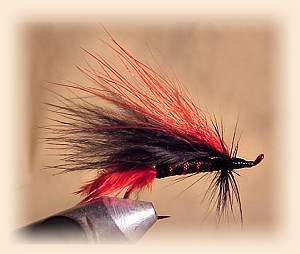Pete's R&B
By Pete Hiatt, Sister, OR
Pete's R&B is a fisherman's fly. It has become my GO TO
fly for steelhead and lake fishing. It is one of those
patterns which simply PERFORMS. I never thought of it as
a lake fly until a friend used it on Diamond Lake near
Crater Lake, Oregon. There is a local patterns called the
Diamond Lake Special which has done very well for me over
the years but my friend used Pete's R&B and seriously out
fished everything else being used including bait. This
pattern uses red which has always been a strike enhancer.
It also uses black marabou which has enticing movement in
water. The pattern is something like a leech pattern and
something like a skunk fly, but is a 100% using fly.
I have two favorite types of hooks. I have always loved
the heavy Eagle Claw #1197 eye down and the eye up hooks
like Gamakatsu and Montana Fly Hooks. I am tying this one
on a red Gamakatsu in size #4. I like #2 for salmon, #4
for steelhead and larger trout and #6 and #4 for regular
trout and sea run cutthroat. This hook is red colored in
keeping with the red colors on the fly.
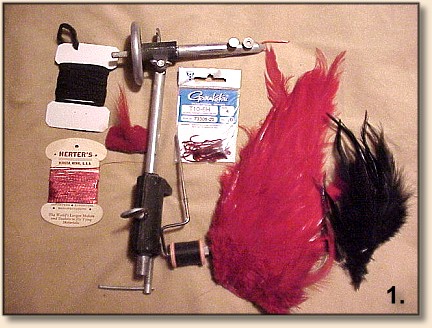
If the vise looks unusual, it is a 40 year old Universal
Rotator. Still my favorite vise. It should be a good one
since I paid almost $10 for it.
We start by applying black thread of whatever size is handy.
I am not picky on this and the fish aren't either. It only
needs to be strong enough to tighten down the hair. With
this in mind, the smaller sizes allow for more error than
thicker thread. I tie my flies to last forever, so I use
head cement in every stage. Do as you like.
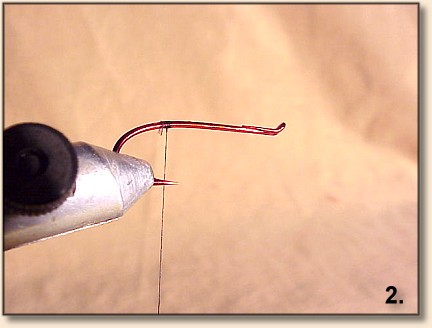
I like movement in the tail, too, so I use the "marabou" type
material from the root of chicken feathers. The color for
this pattern is red.
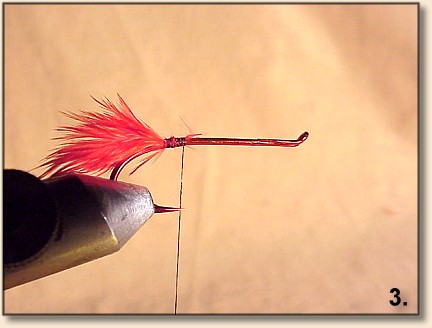
Photo #4 shows the black yarn attached and the hammered red
tinsel attached. A few subtle hints here. I apply the yarn
forward and run it back so the butt is not overly bulbous.
We are not tying a Hillary fly after all. One more valuable
point. The tinsel is tied on at an angle so that the metal
does not crimp and break. The yarn is tied forward and then
the tinsel. They are tied off and more head cement applied.
I HATE FLIES THAT COME APART. Now a comment on why yarn
instead of chenille. When I fish out of a boat in tidewater,
I cast under brush (sometimes unsuccessfully). The brush will
wear off part of the chenille body material but won't bother
yarn. Also the incoming tides are full of leaves in the water
which also wears off the chenille. For this reason, I never
use chenille. One more comment on the body. When using a red
or orange body, they seem to perform better when quite fat.
It doesn't seem to matter when it is black.

Photo #5 shows the body material tied off.
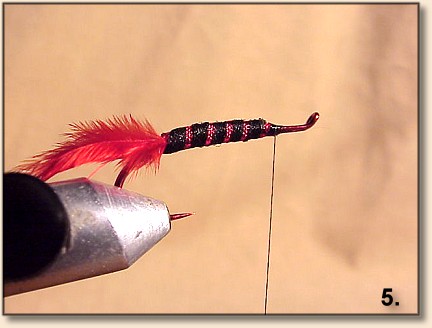
Now comments on hackle. This fly uses black hackle but WHAT
TYPE OF BLACK HACKLE? The answer depends on how deep you want
to fish the fly. You can tie soft hen hackle or sparsely tied
rooster hackle if you want to fish down. If you want to fish
it closer to the surface which I always do for sea run cutts,
use rooster hackle tied thicker. I dislike weighting flies so
I vary hook type and size and tying characteristics instead.
Just keep in mind what your fishing preferences are.
Remember to leave room to tie the head. That is a very common
error in nearly all flies.
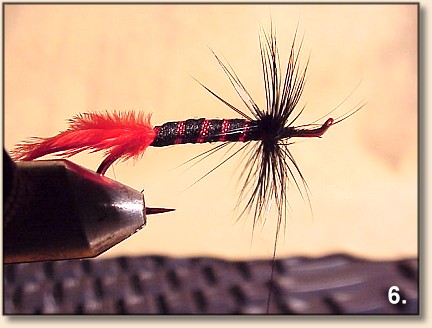
Photo #6 shows the hackle tied on and cemented.
Now we tie on the marabou underwing as I call it.
Photo #7 shows the underwing tied and cemented.

Photo #8 shows the red Polar Bear tied and cemented. You
need to clamp this down well and cement well as the hair
is slick and can get away from you. Some pre-glue the hair
together before applying it. A rubbery glue works best if
you do this. Polar bear hair can still be legally purchased
in the US.
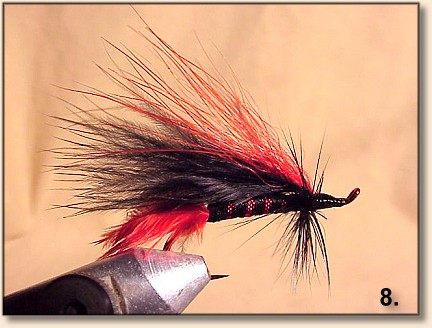
Now for the head. The head can be very important. Some like
it very small. I prefer it larger and buggy. Some might apply
eyes. I have not found it necessary in this pattern. Simply
form it to your preference, liberally cement, and go fishing.
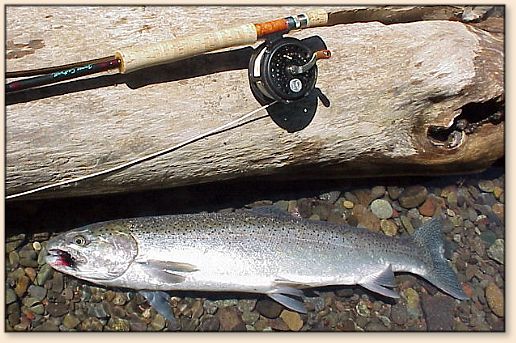
The photo above shows that it works. This was on the North
Santiam River in Oregon on a hatchery steelie of about 6 pounds.
You can read this fishing article
HERE. ~ Whopper Bubba, Oregon
|

